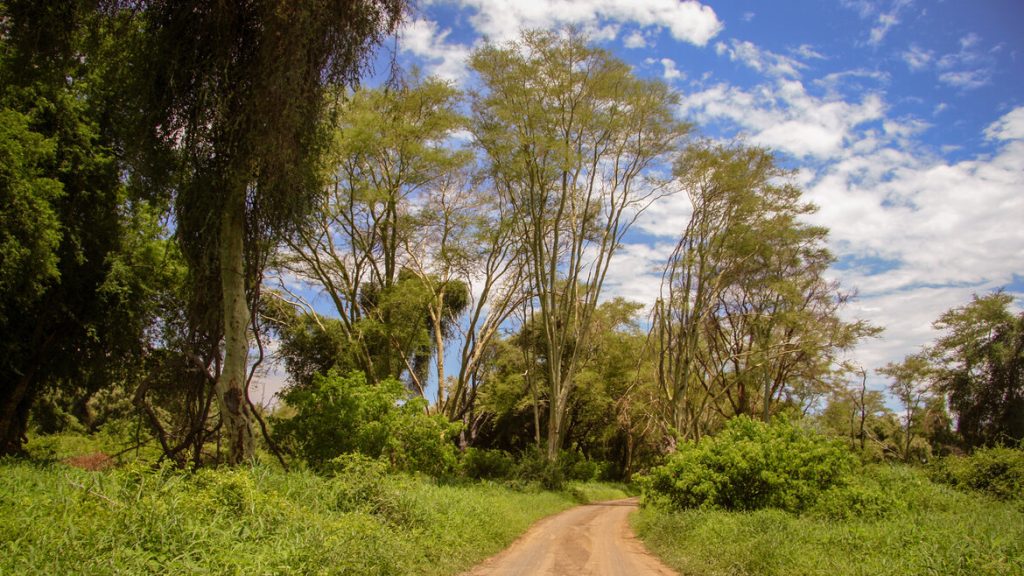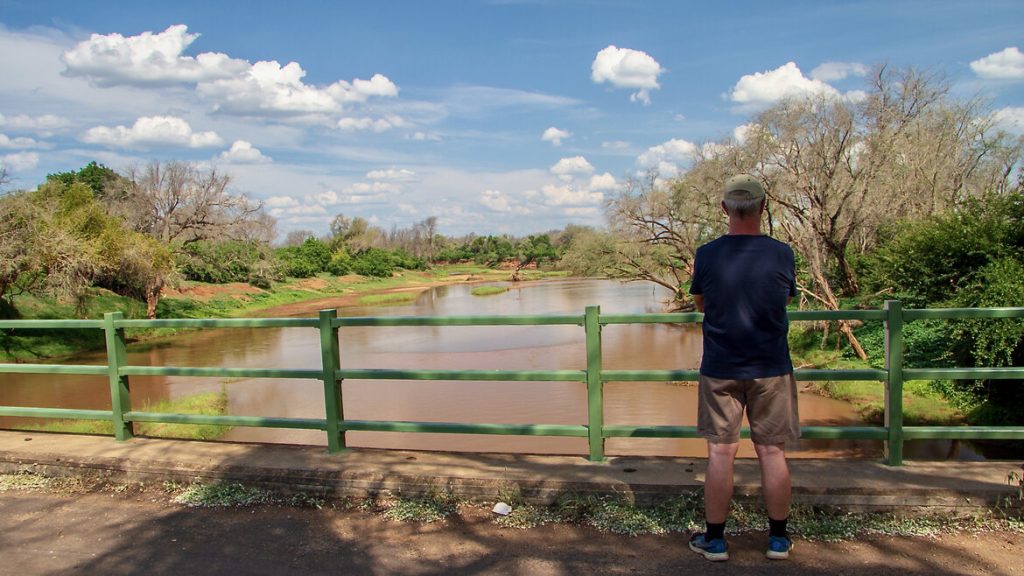When I first came across Crooks Corner on a map of the Kruger National Park, I didn’t give the name a second thought. I assumed that in days gone by, someone called Crook lived there. I forgot that place names often have an intriguing story behind them.
Instead, I focussed on the Limpopo River, which happens to flow through Crooks Corner.
You see, long ago, when I was a child, I read that The Elephants Child and his family went to a particular spot on the river to get their trunks lengthened. Kipling described a wonderful place ‘… on the banks of the great grey-green greasy Limpopo River, all set about with fever trees…’ that captured my young imagination.
So much so that whenever we are anywhere near the Limpopo River, my inner child’s curiosity must be indulged with a visit. You never know; this time, we might find the place where the ‘satiable Elephant’s child’ got its trunk from.
But first,
Where is Crooks Corner?
You’ll find Crooks Corner tucked away in a remote northeastern corner of South Africa’s Kruger National Park.
Here, the Luvuvhu River joins the mighty Limpopo to form a tiny triangular sliver of land which marks the meeting point of three countries: Zimbabwe, Mozambique and South Africa.
And this isolated international boundary point should have been my first clue that there is more to Crooks Corner than someone’s name.

Follow the Dirt Road
An elephant waits for us at the Luvuvhu River Drive turnoff to Crooks Corner. He gently waves his trunk from side to side inviting us to proceed down the dirt road. We hesitate. He is a little too close to the edge of the road for comfort.
Sensing our hesitation, with an elephant huff of resignation and a flap of his ears, he turns and leads the way down the sandy track.
We follow him into an astounding wonderland of baobab trees and sandstone koppies on one side of the road. On the other side, enormous nyala and wild fig trees dominate the lush riverine vegetation growing along the Luvuvhu River.

The elephant leads us to the herd, where a young elephant child practices the fine art of pulling out tufts of green grass with its trunk. It will take a bit of work to master this new skill and pick up more than one blade of grass at a time.

Fever Tree Forest
Eventually, we tear ourselves away from the entertaining antics of the elephant child to continue down the dirt road. But it takes a while to reach Crooks Corner because there is so much wildlife here.
Zebras, impalas and sometimes wildebeest crisscross the track ahead of us.
Colourful bee-eaters flit from tree to tree, pausing here and there to sing their sweet songs.
And regal kudus peer at us through the bushes while the nyalas ignore us.
Eventually, the dirt road winds through a ghostly green grove of fever trees. And I know my childhood quest is almost over. Around the next bend, we’ll reach the river and the place where elephants get their long trunks from.

A Haven for Scoundrels
But, alas, my quest continues. There are no elephants at Crooks Corner today.
And neither is the Limpopo River grey-green or greasy. It is a milky chocolate brown, but it is indeed a great river.
Instead, we find a haven for scoundrels in days gone by. According to a SANParks Honorary Ranger plaque marking the spot, Crooks Corner ‘became a natural refuge for all kinds of people who had no great wish to look into the eyes of the law and who might suddenly need to flee across an international border.’
Sometime in the early to mid-1900s, a beacon which has now washed away marked the international boundary between South Africa and what is now Zimbabwe and Mozambique.
Imagine you are an outlaw of some sort, and the South African law shows up. No problem, you hop across the beacon into one of the other countries. You’ll be perfectly safe because they have no jurisdiction across an international border, so they can’t touch you.

It is all in the Name
Now, imagine if all three countries sent their officers of the law to capture you, and they arrived at the same time. Again, it wouldn’t be a problem.
This time you would climb on top of the beacon. Here you would be untouchable because the top of the beacon was a no man’s land. There were no rules defining whose jurisdiction the beacon fell under.
This simple legal loophole was why so many crooks, think ivory poachers, gunrunners, smugglers and other shady characters called this area home. So, it’s only natural that this remote corner between three countries was named Crooks Corner.
Today this corner for crooks is an isolated paradise for the wildlife that calls this place home. And, at sunrise or sunset, when all the tourists are tucked away in distant rest camps, perhaps the elephants walk through the fever tree forest to the mighty milky chocolate Limpopo River. But I doubt they come here to get their trunks lengthened.

Crooks Corner Good to Know
Accommodation near Crooks Corner.
If you want to explore all that Crooks Corner has to offer, it’s best to stay either at Punda Maria rest camp or at Pafuri Border Camp.
I fell in love with Punda Maria Rest Camp. Click the link to read why. But in a nutshell, Punda Maria is a small atmospheric camp beside a waterhole with a beautiful hide. And the best part? The waterhole is floodlit at night, and there’s a swimming pool too.
While the historic Pafuri Border Camp with three self-catering houses is closer to Crooks Corner, it isn’t as budget-friendly as Punda Maria.
So, What Else Is There to Do Near Crooks Corner?
There are several other things to do on the way to or from Crooks Corner.
Pafuri Picnic Spot
Magnificent riverine trees cast their welcome shade over this tranquil picnic spot on the banks of the Luvuvhu River.

Here crocodiles glide by, and sometimes buffalos wallow in the shallows. Kingfishers fish. Bee-eaters flit from branch to branch trilling their sweet song. And if there are few tourists around, the nyalas stroll past the picnic tables. But, unlike Crooks Corner, there are thieves here.
Opportunistic and cunning vervet monkeys steal food right off your table as soon as you turn your back. So do, be wary and keep an eye on your yummy picnic goodies. And please don’t feed the monkeys.
Despite the thieving monkeys, Pafuri Picnic Spot remains my favourite picnic site in the Kruger National Park.
Unlike some of the picnic sites in the south of the Kruger, there is no restaurant here. However, there are braai facilities, or you can rent a skottel from the kiosk, but other than that, make sure to pack everything you’ll need for your picnic.



Luvuvhu River Bridge
If you stay on the main road, about 200 meters after the Crooks Corner Drive turn-off, you’ll find the bridge over the Luvuvhu River. If there is no game on the bridge, you are allowed to get out of your vehicle.
It’s worth stopping here for a bit to stretch your legs. Of course, you might be lucky and see wildlife coming down to the water to drink.

Nyala Drive
If you love baobabs, this is the road to take. It’s a short loop off the main road near the Luvuvhu River bridge.



Klopperfontein Dam
If you’re staying at Punda Maria Rest Camp, don’t miss a stop at Klopperfontein Dam. Switch off your car, reach for a cold drink from the picnic basket and wait a while. This is a key water source for wildlife in the area, so antelope, buffalo or elephants are bound to come to the dam for a drink.

A Final Note on Driving to Crooks Corner
The round trip from Punda Maria Rest Camp to Crooks Corner is approximately 160 kilometres. If you have good game viewing, it can take you all day to do this drive.
This area of Kruger is remote, there are no shops or filling stations along the way, so fill your tank at Punda Maria and pack plenty of water and cold drinks, especially in summer.
And if you have a question about Crooks Corner or would like to share your experience and thoughts, I’d love to hear from you in the comments below.
DISCLOSURE: I have no commercial relationship with SANParks or any of their affiliates. All photographs, experiences and opinions expressed in this blog post are my own.
Are you on Pinterest? How about saving one of these pins to read for later?




8 comments
We are hoping to plan a return visit to South Africa and visit Kruger next year. So this post was a great tease on why we need to get these plans firm. A visit to Crooks Corner with views of elephants and other animals would be awesome. Interesting to read about the history and how this spot was named. I sure hope that poaching is well on the decline these days.
I’m glad my postcard from the road whetted your appetite for the far north of Kruger. Sadly, the war against poachers is ongoing, but I understand that our anti-poaching teams are winning some battles.
Still on my wish list. Hope to get there in ’24 maybe. Great info. Saving
Hope to see you in ’24, Laureen. And if you need any help planning your trip or while you are here, feel free to contact me.
Ah, lovely post Jen and your photos are gorgeous! Missing that top corner of the Kruger and of course missing you too! Makes me homesick but had a a lovely read about your experience.
We, Kruger and I, miss you more. I’m glad my postcards from the road remind you of your old home.
I too was raised with the image of the great grey-green greasy Limpopo River, and was so excited when I finally got to it. I’d have to look at a map to figure out which county I was in. I remember watching the sunset over the river, and elephants. It would have been back in 1980. A whole different era.
Crooks Corner sounds truly wonderful, and I enjoyed your story about the name, and the ellies.
I don’t think it has changed much since then, Alison. Maybe one or two trees have fallen, and there is now a historical plaque but other than that, I suspect it’s still the same.